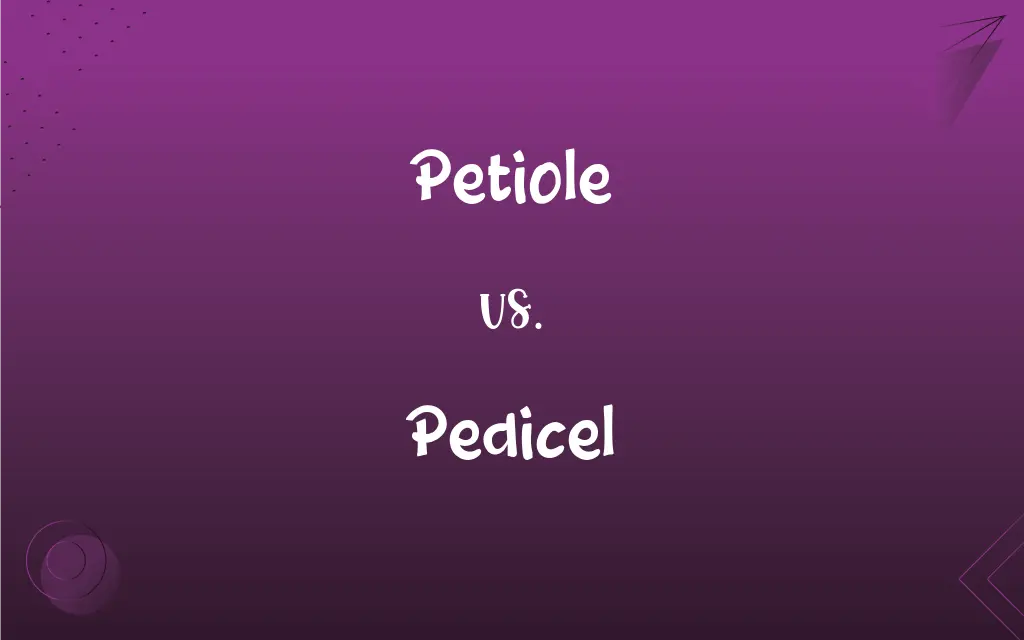Petiole vs. Pedicel: What's the Difference?
Edited by Aimie Carlson || By Harlon Moss || Published on January 30, 2024
A petiole is the stalk that attaches a leaf to the stem, while a pedicel is the stalk connecting a flower to the inflorescence.

Key Differences
The petiole serves as a connection between the leaf and the stem, providing structural support and transport pathways for nutrients and water. In contrast, the pedicel connects a flower to the main stem or a larger part of the inflorescence, supporting the flower.
Petioles can vary greatly in length, shape, and color, influencing leaf positioning and sunlight exposure. Pedicels, on the other hand, can affect flower positioning for optimal pollination and can also vary in length and flexibility.
In some plants, petioles have the ability to photosynthesize, contributing to the plant’s energy production. Pedicels, while typically not photosynthetic, are crucial for the reproductive phase, holding flowers in positions advantageous for pollinator attraction.
Certain plants exhibit modified petioles with unique functions, such as tendrils for climbing. Similarly, pedicels can have specialized adaptations, like elongation or shortening to position the flower for specific pollinators or seed dispersal strategies.
The absence or presence of a petiole can classify leaves as sessile or petiolate, impacting the leaf's overall morphology and function. The length and strength of a pedicel can influence the flower's exposure to potential pollinators and environmental factors.
ADVERTISEMENT
Comparison Chart
Connection
Attaches leaf to stem
Attaches flower to inflorescence
Length Variation
Varies, influencing leaf positioning
Varies, influencing flower positioning
Function
Supports leaf, transports nutrients
Supports flower, assists in reproduction
Photosynthesis
Can be photosynthetic in some plants
Typically not photosynthetic
Special Adaptations
May form tendrils or other structures
Can adapt for specific pollination strategies
ADVERTISEMENT
Petiole and Pedicel Definitions
Petiole
A petiole is the stalk connecting a leaf to the stem of a plant.
The petiole of the leaf was long, elevating it towards the sunlight.
Pedicel
Pedicels can vary in length, influencing the arrangement of flowers on a plant.
Long pedicels gave the plant a loose, airy appearance.
Petiole
Petioles function as conduits for nutrient and water transport from the stem to the leaf.
The thick petiole provided a robust channel for nutrients to reach the leaf.
Pedicel
Pedicels support flowers and help position them for pollination.
The flower's pedicel angled it perfectly for visiting bees.
Petiole
In some plants, the petiole may also perform photosynthesis.
This plant's petiole is green and photosynthetic, contributing to its energy production.
Pedicel
A pedicel is the stalk that attaches a single flower to the main stem or inflorescence.
Each flower in the cluster was connected to the branch by a slender pedicel.
Petiole
A petiole can vary in length, affecting the leaf’s exposure to light and air.
Leaves with shorter petioles were shaded, while those with longer petioles were fully sunlit.
Pedicel
Pedicels may exhibit adaptations to enhance pollination or seed dispersal.
The plant's pedicels elongated after blooming to better disperse seeds.
Petiole
Petioles may have specialized forms like tendrils for climbing in some species.
The vine's petioles had evolved into tendrils, aiding its climb up the trellis.
Pedicel
The strength and flexibility of a pedicel can affect a flower's interaction with the environment.
The sturdy pedicels held the flowers upright despite the wind.
Petiole
(Botany) The stalk by which a leaf is attached to a stem. Also called leafstalk.
Pedicel
A small stalk or stalklike part bearing a single flower in an inflorescence.
Petiole
(Zoology) A slender, stalklike part, as that connecting the thorax and abdomen in certain insects.
Pedicel
A support for a fern sporangium or moss capsule.
Petiole
(botany) The stalk of a leaf, attaching the blade to the stem.
Petiole
A narrow or constricted segment of the body of an insect; especially, the metasomal segment of certain Hymenoptera, such as wasps.
Petiole
(entomology) The stalk at the base of the nest of the paper wasp.
Petiole
A leafstalk; the footstalk of a leaf, connecting the blade with the stem. See Illust. of Leaf.
Petiole
A stalk or peduncle.
Petiole
The slender stem that supports the blade of a leaf
FAQs
Do all flowers have pedicels?
Most flowers have pedicels, but some are sessile, meaning they attach directly to the stem.
What is a pedicel?
A pedicel is the stalk that connects a flower to the inflorescence or main stem.
What is a petiole?
A petiole is the stalk that connects a leaf to a plant's stem.
Can a petiole perform photosynthesis?
Yes, in some plants, petioles can perform photosynthesis.
Can the length of a pedicel vary?
Yes, pedicel length can vary greatly, affecting the overall appearance of the flower arrangement.
Do petioles have other functions besides supporting leaves?
Besides support, petioles transport nutrients and water and can have specialized adaptations.
How does the length of a petiole affect a leaf?
The length of a petiole influences the leaf's positioning for optimal light and air exposure.
Can a petiole's length change over time?
Generally, a petiole's length is fixed once it forms, but it may appear to change as the leaf grows.
What role does a pedicel play in pollination?
Pedicels position flowers for effective pollination by exposing them to pollinators.
What happens if a plant lacks petioles?
If a plant lacks petioles, its leaves are directly attached to the stem, known as sessile leaves.
Are petioles only found in flowering plants?
Petioles are common in flowering plants but can also be found in some non-flowering plants.
Are petioles and pedicels present in all species of plants?
Most flowering plants have petioles and pedicels, but their presence and form can vary among different species.
How does a pedicel support a flower?
A pedicel supports a flower by holding it upright and connecting it to the plant's water and nutrient supply.
Are there plants with modified petioles?
Yes, some plants have modified petioles that serve additional functions like climbing.
Can the absence of pedicels affect a plant's reproduction?
Yes, the absence or modification of pedicels can impact a plant's reproductive process and success.
Can environmental factors affect the growth of petioles?
Yes, environmental factors like light, water, and nutrients can influence petiole growth and development.
Is a pedicel necessary for a flower's survival?
While not always necessary, a pedicel is crucial for positioning and protecting a flower.
Are pedicels always rigid?
No, the rigidity of pedicels varies, with some being quite flexible to allow movement.
Do pedicels have any special adaptations in certain plants?
Yes, in some plants, pedicels have adaptations like elongation or stiffness for specific reproductive strategies.
Do pedicels influence how a flower cluster looks?
Yes, the length and arrangement of pedicels greatly influence the overall appearance of flower clusters.
About Author
Written by
Harlon MossHarlon is a seasoned quality moderator and accomplished content writer for Difference Wiki. An alumnus of the prestigious University of California, he earned his degree in Computer Science. Leveraging his academic background, Harlon brings a meticulous and informed perspective to his work, ensuring content accuracy and excellence.
Edited by
Aimie CarlsonAimie Carlson, holding a master's degree in English literature, is a fervent English language enthusiast. She lends her writing talents to Difference Wiki, a prominent website that specializes in comparisons, offering readers insightful analyses that both captivate and inform.







































































